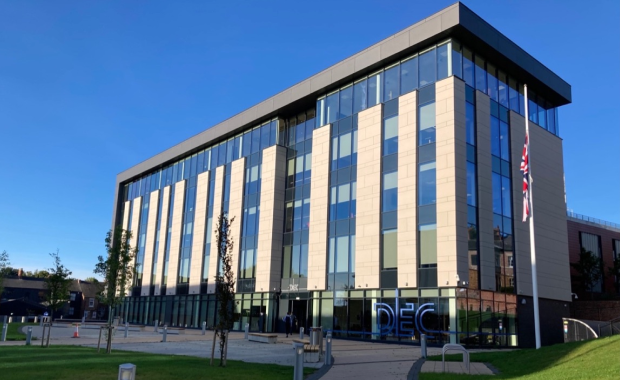News - Construction News
Planning application submitted for major new government hub in Darlington

The Government Property Agency (GPA) has submitted a planning application to Darlington Borough Council to build a four-storey government hub to support the ongoing success and growth of the Darlington Economic Campus (DEC).
The government is investing circa £118M in the project, which is a significant indication of its commitment to sparking economic growth in the town and wider region; according to research from the CBI, every £1 spent in the UK’s construction sector helps create £3 of value to the wider UK economy.
When completed, Brunswick Street will form part of a government campus of three buildings, including Feethams House and Bishopsgate House, all located within Darlington town centre.
During his visit to meet with senior officials based in Darlington today, Parliamentary Secretary for the Cabinet Office, Alex Burghart, said: “Brunswick Street, situated right in the heart of Darlington, will soon be home to a critical government hub, and as the government footprint in North England continues to grow, we will create further opportunities for people from across the country to work in the civil service.
“This is an incredibly exciting time for Darlington as we begin the process of delivering a landmark, sustainable, place-making building which the entire community can take pride in.
“Not only will this help drive regional economic growth, but it will also ensure that we create a civil service that better represents the diverse communities it serves.”
Construction of the new government hub is set to begin later this year and be completed in early 2027. The new hub will increase the total number of Darlington-based civil servants working to over 2,300, 1,450 of whom will be located in the Brunswick Street hub. Since 2021, 762 civil service roles have been relocated to Darlington under Places for Growth.
Over 800 civil servants are currently based in Darlington across eight departments, including His Majesty’s Treasury (HMT), the Department for Education, and the Department for Business and Trade (DBT), for whom Darlington is their second headquarters.
The DBT itself has more than 250 staff stationed there, over 200 of which have been locally recruited. Darlington has been a welcome addition to DBT’s Places for Growth network, which now boasts five other locations, including Belfast, Cardiff and Salford.
Clive Anderson, Director of Capital Projects at the GPA, said: “In submitting our planning application, we are a step closer to creating another highly sustainable new government hub which will boost the local economy and see a modern, inspirational and energy-efficient workplace for government departments and their staff attracted to a rewarding civil service career based in Darlington.”
The campus is enabling increased investment in the region and supporting the Government’s Levelling Up and Places for Growth agendas, creating circa 1,400 Civil Service roles and providing future growth opportunities to the North East of England.
Second Permanent Secretary to the Treasury Beth Russell, who is based in Darlington, said: “Today marks a major milestone for the Darlington Economic Campus as it moves one step closer to its permanent home. We are already giving hundreds of local people the opportunity to work at the heart of government from here in the north east, making government policymaking more reflective of the communities we serve.”
This latest development forms part of the Government Hubs Programme, which supports economic growth across the UK, catalyses the regeneration of brownfield sites and repurposes existing buildings to create efficient, sustainable, and productive workplaces.
Other government departments based at the DEC include the Department for Levelling Up, Housing & Communities (DLUHC), the Office for National Statistics (ONS), the Department for Culture, Media and Sport (DCMS), the Competition and Markets Authority (CMA), the Department for Energy Security and Net Zero (DESNZ), the Department for Science, Innovation and Technology (DSIT), and the Department for Education (DfE).
By locating these departments alongside each other, departments have also increased opportunities for cross-government collaboration.
If you would like to read more stories like this, then please click here
Related Articles
More News
- Building Britain: Ibstock ready to play their part in getting Britain building again
25 Jul 24
After Labour’s landslide win in July’s General Election, incumbent Chancellor of the Exchequer Rachel Reeves
- Get Britain Building
24 Jul 24
The King said: "My ministers will get Britain building.
- Cool roofs are best at beating cities’ heat
23 Jul 24
Painting roofs white or covering them with a reflective coating would be more effective at






